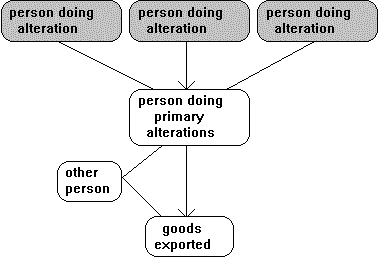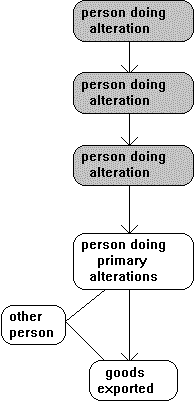Explanatory Memorandum
(Circulated by the authority of the Treasurer the Hon Ralph Willis, M.P.)CHAPTER 14 - SALES TAX - CREDIT FOR PARTS USED IN THE ALTERATION OF GOODS INTENDED FOR EXPORT
Overview
14.1 The Bill will amend the Sales Tax Assessment Act 1992 to allow a credit for tax borne on parts, fittings or accessories used in the repair, renovation or upgrading of goods to be exported, to the extent that the tax has not been passed
14.2 To remove the element of sales tax on parts, fittings or accessories that are used in the repair, renovation or upgrading of goods that are to be exported, whilst ensuring that where the goods that were exported, return to Australia, sales tax is levied on the parts, fittings and accessories that were used in the earlier repair, renovation or upgrading. [Clause 129]
14.3 The amendment to provide the credit will apply from 1January1993 whilst the amendment to tax the returned goods will apply from the date the Bill receives Royal Assent. [Subclause 2(1) and clause137]
Background to the legislation
14.4 The general scheme of the legislation is that assessable goods which are the subject of an assessable dealing will be taxable, unless an exemption applies. One of the exemptions available is in respect of an assessable dealing with goods that are to be exported.
14.5 The legislation provides a range of exemptions and credit grounds to deal with the export of goods. In general these provisions are tied to a requirement that the goods are not used in Australia prior to export.
14.6 Using goods as raw materials in manufacture or repair of other goods to be exported results in the raw materials being used in Australia prior to export. Where the raw materials are used in manufacture, provision is made for exemption to apply. However, where the raw materials are used in repair of goods to be exported, exemption does not apply.
14.7 Thus, for example, an Australian engine put in a new car that is exported will qualify for exemption, but an Australian engine put in a boat brought to Australia for repair and later export will be taxable.
14.8 Where raw materials are imported from overseas to be used in the repair of goods imported into Australia for repair and to be exported after the repair, a credit of sales tax is provided as a result of an interconnection with the Customs legislation. However if Australian raw materials are used as mentioned earlier, sales tax is payable.
14.9 Under the sales tax legislation that existed prior to 1 January 1993, the exemption item covering goods for export or to be exported lead to doubt as to what could be covered. It was argued that raw materials used in the repair of goods for export were actually goods to be exported. It is doubtful that such an interpretation was valid, however the new legislation applying from 1 January 1993 ensured that exemption did not apply.
14.10 The effect of taxing raw materials in these circumstances is to have an element of sales tax in the cost of the goods being repaired and exported.
Explanation of the amendments
14.11 The amendments are broken up into two distinct facets:
- •
- a credit for parts, fittings and accessories used in the repair, renovation or upgrading (alteration) of goods to be exported, including parts etc. that are used in the alteration of goods that in turn will be used in the alteration of other goods for export [clauses 131, 133, and 136] ; and
- •
- a set of taxing provisions where the goods that were altered are re-imported [clauses 131, 132, 134 and 136] .
14.12 The available credit is built around a new concept, "export alteration goods". This concept has a number of important facets:
- •
- the materials used must be parts, fittings or accessories;
- •
- the materials must become an integral part of the altered goods;
- •
- these altered goods can in turn be used as parts, fittings or accessories of other altered goods (this process can occur any number of times, for example a gear can be used to repair a gearbox which in turn can be used to repair a boat);
- •
- before export, all of the various altered goods cannot be used in any way apart from being used to alter other goods as described above;
- •
- if the person who exports the final altered goods is not the person who actually carried out the alteration, then that first person must give the claimant a certificate, in a form approved by the Commissioner, attesting to the fact that the goods have been exported;
- •
- for a claimant to be entitled to a credit, the claimant must be able to show that the tax borne has not been passed on, and if it has, then that it has been refunded to the customer. [Clauses131,133and 136]
14.13 This is not a term defined in the legislation so the ordinary meaning applies in the context of the legislation. To be an integral part means that the material must belong as a part of the whole unit. It is a component or constituent of the unit which is required for the unit to operate. Thus gears in a gearbox, oil in a motor, hydraulic oil in a car braking system and an engine in a car are all integral parts. However, film in a camera, petrol in the fuel tank of a motor vehicle and batteries in a torch are not integral parts because they are not a permanent part of the whole unit.
What if I am not the person altering the goods to be exported but am altering other units that are to be used in the final alteration?
14.14 The provision is wide enough to cover a range of persons carrying out alterations that will ultimately be part of goods being exported. The provisions will cover persons who carry out subcontract work for others as well as the primary person carrying out the alteration.
14.15 Thus, as depicted in the following diagram, various persons subcontracting to carry out part of the alteration will be covered. An example would be an engine reconditioner, a radar repairer and an upholsterer contracting to a boat repairer to carry out the necessary repairs to those parts of a boat during the course of a refit by the boat yard for an overseas owner.

14.16 Similarly, contractors who carry out work for others who in turn are supplying to the primary claimant, as depicted in the diagram below will also be able to claim the credit, provided all the other requirements are met. An example of this type of work is a machine shop, purchasing materials to recondition a marine engine for a marine engine builder. The marine engine builder then uses the reconditioned unit plus other new parts to fully rebuild an engine which will be supplied to the boat yard carrying out a refit of an overseas yacht.

14.17 There is no impediment, within the legislation, to any number of contractors in either scenario nor to a mixing of the types. However, in practical terms it may prove very difficult to ensure that both the required certificates are received from the exporter and the passing on provisions are met. The purpose of the passing on requirement is to ensure that where a credit is being claimed, no part of the tax borne will ever be passed on in respect of any of the work being carried out on the goods being exported. [Clause 133]
What does it mean to export and can I do anything with the goods prior to export?
14.18 Export means to send the goods overseas to a foreign destination. Where the goods being exported return to Australia, specific provision has been incorporated to tax the goods.
14.19 For goods to be "export alteration goods" they must not be used other than in further alteration before they are exported. At times, export involves some small amount of usage. For example an overseas boat may be sailed into Australia for repair and will then sail out again. The time taken to sail directly from Australia is considered to be insignificant and will not affect the entitlement. However, where the boat was used to spend 3 months sailing around Australia before it left, that would be considered use that would prevent an entitlement to credit.
14.20 Where goods are stored for a period prior to export, this will also not be use that would prevent the credit. However, placing goods into retail stock in a retail store and later deciding to export the goods would be use that would prevent an entitlement to a credit. [Clause 133]
14.21 The Commissioner will issue an advice detailing the format of the required certificate for claimants who are not the exporter. Exporters will need to provide evidence of export without use, apart from further alterations, before the export. [Clause 133]
14.22 The credit will apply to "export alteration goods" where the alteration of the goods occurred, or occurs, on or after 1 January 1993. [Subclause 137(1)]
14.23 As a means of both preventing tax avoidance and ensuring that goods that return to Australia are taxed, provisions have been incorporated to subject the reimported goods to sales tax.
14.24 The effect of the provisions is as follows:
- •
- if the goods that were exported have not gone into use or consumption in Australia (where goods are entered for repair etc. on a duty drawback system, they do not go into use or consumption in Australia), the goods will be taxed in the same way as any other goods being imported into Australia, that had not been used in Australia i.e. on their full value;
- •
- if the goods that were exported are goods that have gone into use or consumption in Australia, for example second hand computers that were used in business in Australia, and have been further altered overseas, they will be taxed on the value of the overseas alterations (as per section 42 of Sales Tax Assessment Act 1992 ) plus the value of the export alteration goods:
-
Value of overseas alterations + value of export alteration goods - [clauses 132, 134 and 135];
- •
- if the goods that were exported are goods that have gone into use or consumption in Australia, for example second hand computers that were used in business in Australia, and have not been altered overseas, they will be taxed on the value of the export alteration goods:
- Value of export alteration goods
- [clauses132,134and136].
14.25 The taxing provisions will apply to goods that are imported on or after the Bill receives Royal Assent. [Subclauses 2(1) and 137(2)]
Copyright notice
© Australian Taxation Office for the Commonwealth of Australia
You are free to copy, adapt, modify, transmit and distribute material on this website as you wish (but not in any way that suggests the ATO or the Commonwealth endorses you or any of your services or products).
